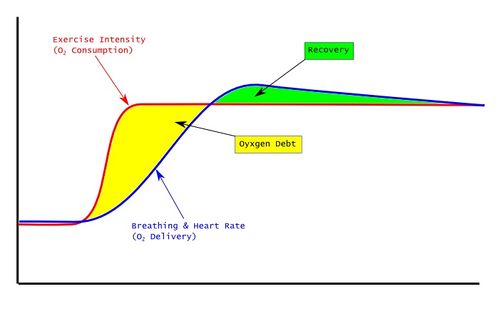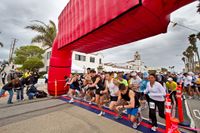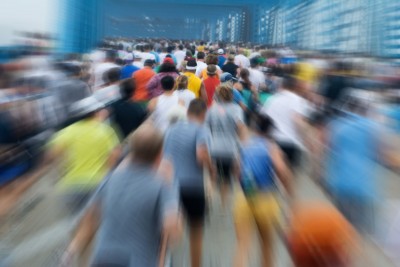Difference between revisions of "Going out too fast"
User:Fellrnr (User talk:Fellrnr | contribs) (→Faster than race pace) |
User:Fellrnr (User talk:Fellrnr | contribs) |
||
| Line 1: | Line 1: | ||
| − | [[File: | + | [[File:Runners Streaming Past 6189982 s.jpg|right|thumb|500px|Runners going faster than you at the start creates the illusion that you're going too slow.]] |
Starting a race at too fast a pace is a remarkably common problem. We'll define what 'too fast' means, then look at the causes, the consequences, and some solutions for covering the first mile or so too quickly. | Starting a race at too fast a pace is a remarkably common problem. We'll define what 'too fast' means, then look at the causes, the consequences, and some solutions for covering the first mile or so too quickly. | ||
=How fast is 'too fast'?= | =How fast is 'too fast'?= | ||
| Line 11: | Line 11: | ||
There are different causes for going out faster than race pace and for going out faster than [[VO2 Kinetics|V̇O<sub>2</sub> Kinetics]]. | There are different causes for going out faster than race pace and for going out faster than [[VO2 Kinetics|V̇O<sub>2</sub> Kinetics]]. | ||
==Faster than race pace== | ==Faster than race pace== | ||
| − | [[File: | + | [[File:Race Start.jpg|right|thumb|200px|Race start by [http://www.flickr.com/photos/anthony_goto/ anthony_goto]]] |
Going out too fast is caused partly by the excitement of the race. This excitement releases a surge of adrenaline, which changes our perception of effort and time. I've seen my heart rate while standing at the start line reach well over 100 BPM, a sign of the adrenaline that has been released. A good [[Practical Tapering|taper]] will cause us to feel far stronger at the start of the race than we do in training, compounding the effects of the adrenaline. Another factor behind going out too fast is the optical illusion of having runners around you. On most training runs we have nobody blocking our vision, so we see our forward motion represented by the ground and scenery appearing to move towards us. These visual clues are an important part of our sense of pace. At the start of most races, all we can see is other runners, with little of the ground or scenery visible. Because most of the runners will be moving a similar speed, they will appear stationary, and a key visual clue to our pace is lost. If the other runners are actually going faster, then the illusion becomes more intense on we can get a sense of moving backwards even though we are running faster than we should. | Going out too fast is caused partly by the excitement of the race. This excitement releases a surge of adrenaline, which changes our perception of effort and time. I've seen my heart rate while standing at the start line reach well over 100 BPM, a sign of the adrenaline that has been released. A good [[Practical Tapering|taper]] will cause us to feel far stronger at the start of the race than we do in training, compounding the effects of the adrenaline. Another factor behind going out too fast is the optical illusion of having runners around you. On most training runs we have nobody blocking our vision, so we see our forward motion represented by the ground and scenery appearing to move towards us. These visual clues are an important part of our sense of pace. At the start of most races, all we can see is other runners, with little of the ground or scenery visible. Because most of the runners will be moving a similar speed, they will appear stationary, and a key visual clue to our pace is lost. If the other runners are actually going faster, then the illusion becomes more intense on we can get a sense of moving backwards even though we are running faster than we should. | ||
Revision as of 15:19, 20 January 2012
Starting a race at too fast a pace is a remarkably common problem. We'll define what 'too fast' means, then look at the causes, the consequences, and some solutions for covering the first mile or so too quickly.
Contents
1 How fast is 'too fast'?
There are two ways you can go out too fast; starting faster than race pace, and starting faster than V̇O2 Kinetics.
1.1 Faster than race pace
Starting the race by going faster than the overall race pace generally produces a disproportionate slow down towards the end. Ideally, the first mile or so of the race should be close to the overall race pace.
1.2 Faster than V̇O2 Kinetics
If we go from standing to running at race pace (or faster), our oxygen delivery will lag behind our oxygen consumption as our heart rate gradually increases, causing an oxygen debt (see image below). This oxygen debt causes us to be too anaerobic for the race. So even if we go out at race pace, without sufficient Warmup this may still be 'too fast'.

2 The causes
There are different causes for going out faster than race pace and for going out faster than V̇O2 Kinetics.
2.1 Faster than race pace

Going out too fast is caused partly by the excitement of the race. This excitement releases a surge of adrenaline, which changes our perception of effort and time. I've seen my heart rate while standing at the start line reach well over 100 BPM, a sign of the adrenaline that has been released. A good taper will cause us to feel far stronger at the start of the race than we do in training, compounding the effects of the adrenaline. Another factor behind going out too fast is the optical illusion of having runners around you. On most training runs we have nobody blocking our vision, so we see our forward motion represented by the ground and scenery appearing to move towards us. These visual clues are an important part of our sense of pace. At the start of most races, all we can see is other runners, with little of the ground or scenery visible. Because most of the runners will be moving a similar speed, they will appear stationary, and a key visual clue to our pace is lost. If the other runners are actually going faster, then the illusion becomes more intense on we can get a sense of moving backwards even though we are running faster than we should.
2.2 Faster than V̇O2 Kinetics
Going faster than our V̇O2 Kinetics can cope with is caused by a failure to Warmup correctly.
3 The consequences
3.1 Faster than race pace
Optimal race performance is generally accepted to come from relatively even split times. There is debate around the advantages of running perfectly even splits, running slightly faster at the end (negative splits), or slowing down slightly towards the end (positive splits). However, running the first mile significantly faster than the average race pace causes a disproportionate slow down towards the end. This is because any race requires finding the right pace that will use all of the body's capacity for the race distance. Using too much of the body's capacity early in the race causes a debt that can't be compensated for later. For example, in marathon races where Glycogen reserves are critical to performance, going out too fast will burn a disproportionate amount of Glycogen. This is because Glycogen usage varies nonlinearly with pace. So if you run a mile at 7:45 and a second mile at 8:15, you will use more Glycogen than running two miles at 8:00 pace. There are other mechanisms for shorter races, but the principle is similar.
3.2 Faster than V̇O2 Kinetics
As noted above, if we go out too fast for our V̇O2 Kinetics, we force our body to be more anaerobic than is appropriate for the race. This excessive anaerobic metabolism can be quite disruptive and can impair performance even in longer races such as the marathon, as well is causing problems in shorter races such as the 5K. The shorter races rely on both aerobic and anaerobic metabolism, but performance relies on achieving a balance between the two that can just be tolerated for the distance and the excessive anaerobic metabolism will disrupt this balance. This would be like running the first 100 meters of the 5K as a sprint; the disruption of that initial high intensity would impair performance for the rest of the race.
4 The solutions
There are two parts to solving the problem of going out too fast.
4.1 Faster than race pace
The first, obviously enough, is to go out at the right pace. This is a tricky thing to achieve, because our sense of pace is disrupted by the adrenaline, taper, and the optical illusion of other runners. GPS devices are generally of little help, as they do not provide an accurate reading of the current pace. Setting a GPS watch to display average or lap average pace can help but it is quite a crude metric. Likewise, mile split times are too infrequent to really help. The best option is a sports watch that uses a foot pod to indicate current pace; see Best Running Watch for more details. Using a marathon pace group can work very well if the pacer is good, but sadly it is not uncommon for the pacer to go out too fast.
4.2 Faster than V̇O2 Kinetics
The second part of the solution is to ensure a good Warmup. The correct Warmup strategy will depend on the length of the race, as a 5K is very different from the marathon. See Warmup for more details.
